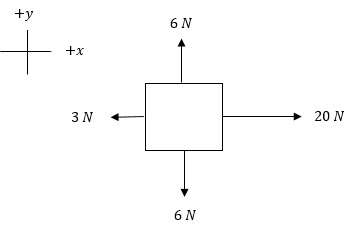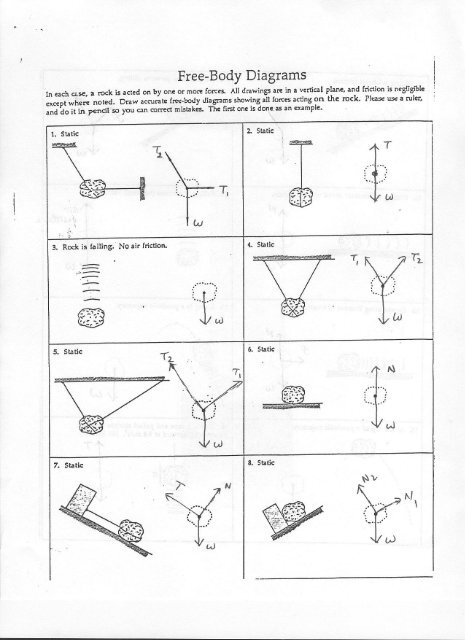Master Free Body Diagrams with Our Physics Worksheet

Free Body Diagrams (FBDs) are a cornerstone of physics problem-solving, providing a visual representation of forces acting on an object. This skill is crucial for mastering physics, whether you are a student preparing for exams or an enthusiast delving deeper into the subject. Here's a comprehensive guide to understanding and mastering Free Body Diagrams through a well-designed physics worksheet.
What is a Free Body Diagram?

A Free Body Diagram is a diagrammatic representation where an object is isolated from its surroundings and all the forces acting on it are drawn as vectors emanating from the center of the object.
Why Use Free Body Diagrams?

- Clarity: They simplify complex scenarios by focusing only on the forces relevant to the problem.
- Problem Solving: They help in setting up equations of motion by clearly showing which forces are balanced or unbalanced.
- Visualization: It aids in visualizing physical concepts, making abstract ideas more tangible.
Steps to Create a Free Body Diagram

Here is a step-by-step guide on how to construct a Free Body Diagram:
- Isolate the Object: Draw a simple sketch of the object under consideration.
- Identify Forces: List all the forces acting on the object:
- Weight (or gravitational force)
- Normal Force
- Friction
- Applied Forces
- Spring Forces (if applicable)
- Draw the Forces: Represent each force as a vector starting from the center of the object:
- Label each force with its type and direction.
- Use arrows to show the direction of each force.
- Ensure forces are not drawn to scale unless specifically required.
- Analyze: Check if all forces are accounted for and whether they follow Newton's laws of motion.
Common Forces in FBDs

Let's explore the most common forces you'll encounter:
| Force Type | Description |
|---|---|
| Weight (mg) | Directed downward towards the center of Earth |
| Normal Force (N) | Perpendicular to the surface in contact |
| Friction (f) | Opposes motion, can be static or kinetic |
| Applied Force (Fapp) | Any external force applied by hand or another object |
| Spring Force (Fspring) | Follows Hooke's Law, proportional to displacement from equilibrium |

🚀 Note: Remember that friction depends on the nature of the contact surfaces and the normal force.
Practical Applications

Here's how Free Body Diagrams can be applied:
- Engineering: Designing structures where forces like tension, compression, and torsion are critical.
- Physics Labs: Analyzing forces in setups to understand fundamental principles like torque and equilibrium.
- Transportation: Understanding forces on vehicles for better design in terms of stability, safety, and efficiency.
Common Pitfalls and How to Avoid Them

- Misidentification of Forces: Ensure you recognize all forces. Use a checklist if necessary.
- Directional Errors: Double-check the direction of each force relative to your object.
- Incorrect Magnitude: While diagrams don't need to be to scale, ensure you understand the relative magnitudes of forces.
- Confusing Reactions: Distinguish between external forces applied on the object and reaction forces on other objects.
Physics Worksheet

Here's a sample worksheet to practice drawing Free Body Diagrams:
Question 1:
An apple of mass 0.2 kg is hanging from a tree. Draw its FBD.
Question 2:
A block of mass 10 kg is sliding down a frictionless inclined plane at 30° to the horizontal. Sketch the FBD.
Question 3:
A 5 kg box is being pushed horizontally by a force of 20 N on a rough surface (μk = 0.3). Draw the FBD.
Question 4:
A book of mass 2 kg is at rest on a flat table. Create its FBD considering only vertical forces.
🔍 Note: Work through these examples methodically. Start by listing all forces, then sketch and label each force vector.
As you go through these exercises, you'll notice the application of forces in various contexts, which is key to mastering Free Body Diagrams. Remember, practice is vital in physics. By working through a variety of problems, you not only reinforce your understanding but also build the intuition necessary to tackle real-world challenges.
What are the most important rules for drawing FBDs?

+
Some key rules include identifying all forces, drawing vectors from the center of mass, ensuring all forces are correctly labeled, and understanding their direction relative to the object's orientation.
How do you know if a force should be included in an FBD?

+
Any force that directly affects the object of interest should be included. This includes contact forces like friction or normal forces, as well as non-contact forces like gravity or magnetic forces if relevant.
Can Free Body Diagrams be applied to non-uniform objects?

+
Yes, but they are more complex. Non-uniform objects might require multiple FBDs or special considerations like varying gravitational force distribution due to mass distribution.
In wrapping up this journey through Free Body Diagrams, one can appreciate their indispensable role in physics education. They serve not only as a tool for problem-solving but also as a bridge to understanding how forces interact in real life. By practicing with physics worksheets and internalizing these concepts, students and enthusiasts can gain confidence in tackling more advanced physics topics. The ability to create accurate and comprehensive Free Body Diagrams is fundamental to mastering mechanics, engineering, and any field where the analysis of forces is pivotal.



